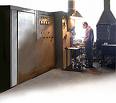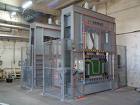Induction heating and tempering installations
In induction installations, the heat in an electrically conductive heated body is released by currents induced in it by an alternating electromagnetic field.
Advantages of induction heating compared to heating in resistance furnaces:
1) Transferring electrical energy directly into the heated body allows direct heating of conductive materials. At the same time, the heating rate is increased compared to installations with indirect action, where the product is heated only from the surface.
2) The transfer of electrical energy directly into the heated body does not require contact devices. It is convenient in the conditions of automated manufacturing production, when vacuum and protective means are used.
3) Due to the phenomenon of surface effect, the maximum power is released in the surface layer of the heated product. Therefore, induction heating during cooling ensures rapid heating of the surface layer of the product.This makes it possible to obtain a high surface hardness of the part with a relatively viscous medium. Induction surface hardening is faster and more economical than other surface hardening methods.
4) Induction heating in most cases improves productivity and improves working conditions.
Induction heating is widely used for:
1) Melting of metals
2) Heat treatment of parts
3) By heating parts or blanks before plastic deformation (forging, stamping, pressing)
4) Soldering and layering
5) Weld metal
6) Chemical and thermal treatment of products
 In induction heating installations, the inductor creates electromagnetic field, leads to a metal part eddy currents, whose greatest density falls on the surface layer of the workpiece, where the greatest amount of heat is released. This heat is proportional to the power supplied to the inductor and depends on the heating time and frequency of the inductor current. By appropriate selection of power, frequency and time of action, heating can be carried out in the surface layer of different thickness or over the entire section of the workpiece.
In induction heating installations, the inductor creates electromagnetic field, leads to a metal part eddy currents, whose greatest density falls on the surface layer of the workpiece, where the greatest amount of heat is released. This heat is proportional to the power supplied to the inductor and depends on the heating time and frequency of the inductor current. By appropriate selection of power, frequency and time of action, heating can be carried out in the surface layer of different thickness or over the entire section of the workpiece.
Induction heating installations, depending on the charging method and the nature of the operation, have intermittent and continuous operation. The latter can be built into production lines and automatic process lines.
Surface induction hardening, in particular, replaces such expensive surface hardening operations as carburizing, nitriding, etc.
Induction hardening installations
Purpose of induction surface hardening: achieving high hardness of the surface layer while maintaining the viscous environment of the part. To obtain such hardening, the workpiece is rapidly heated to a predetermined depth by the current induced by the surface layer of the metal, followed by cooling.
The depth of current penetration into the metal depends on the frequency, then surface hardening requires different thicknesses of the hardened layer.
There are the following types of induction surface hardening:
1) Simultaneously
2) Simultaneous rotation
3) Continuous-sequential
 Simultaneous induction hardening — consists in simultaneous heating of the entire surface to be hardened, followed by cooling of the surface. It is convenient to combine the inductor and the cooler. The application is limited by the power of the power generator. The heated surface does not exceed 200-300 cm2.
Simultaneous induction hardening — consists in simultaneous heating of the entire surface to be hardened, followed by cooling of the surface. It is convenient to combine the inductor and the cooler. The application is limited by the power of the power generator. The heated surface does not exceed 200-300 cm2.
Simultaneous-sequential induction hardening — characterized by the fact that the individual parts of the heated part are heated simultaneously and sequentially.
Continuous sequential induction hardening - used in the case of a large length of the hardened surface and consists in heating the part of the part during the continuous movement of the part relative to the inductor or vice versa. Surface cooling follows heating. It is possible to use separate coolers or combine them with an inductor.
In practice, the idea of induction surface hardening is applied in induction hardening machines.
There are special induction hardening machines designed to process a specific part or groups of parts, slightly different sizes, and universal induction hardening machines for processing any part.
Curing machines include the following items:
1) Step-down transformer
2) Inductor
3) Battery capacitors
4) Water cooling system
5) Machine control and management element
 Universal machines for induction hardening are equipped with devices for fixing parts, their movement, rotation, the possibility of replacing the inductor. The design of the hardening inductor depends on the type of surface hardening and the shape of the surface to be hardened.
Universal machines for induction hardening are equipped with devices for fixing parts, their movement, rotation, the possibility of replacing the inductor. The design of the hardening inductor depends on the type of surface hardening and the shape of the surface to be hardened.
Depending on the type of surface hardening and the configuration of the parts, different designs of hardening inductors are used.
The device for curing inductors
An inductor consists of an inductive wire that creates an alternating magnetic field, busbars, terminal blocks for connecting the inductor to a power source, pipes for supplying and draining water. Single and multi-turn inductors are used to harden flat surfaces.
There is an inductor for hardening the outer surfaces of cylindrical parts, inner flat surfaces, etc. There are cylindrical, loop, spiral-cylindrical and spiral flat. At low frequencies, the inductor may contain a magnetic circuit (in some cases).
Power supplies for curing inductors
Electric machine and thyristor converters, providing operating frequencies up to 8 kHz, serve as power sources for medium frequency quenching inductors.To obtain a frequency in the range of 150 to 8000 Hz, machine generators are used. Valve controlled converters can be used. For higher frequencies tube generators are used. In the field of increased frequency, machine generators are used. Structurally, the generator is combined with the drive motor in one conversion device.
For frequencies from 150 to 500 Hz, conventional multipole generators are used. They work at high speeds. The excitation coil located on the rotor is fed through the ring contact.
For frequencies from 100 to 8000 Hz, inductor generators are used, the rotor of which does not have a winding.
In a conventional synchronous generator, the excitation winding rotating with the rotor creates an alternating flux in the stator winding, then in the induction generator, the rotation of the rotor causes a pulsation of the magnetic flux associated with the magnetic winding. The use of an induction generator with an increased frequency is due to the design difficulties of generators operating at a frequency > 500 Hz. In such generators, it is difficult to place multipole stator and rotor windings; the drive is done by asynchronous motors. With power up to 100 kW, the two machines are usually combined in one housing. High power - two cases Induction heaters and cooling devices can be powered by machine generators using induction or central power.
Induction power is useful when the generator is fully charged by a single unit running continuously in metal heating elements.
Central power supply — in the presence of a large number of heating elements operating cyclically.In this case, it is possible to save the installed power of the generators due to the simultaneous operation of separate heating units.
Generators are usually used with self-excitation, which can provide power up to 200 kW. Such lamps operate at an anode voltage of 10-15 kV; water cooling is used to cool the anode lamps with a dissipated power of more than 10 kW.
Power rectifiers are usually used to obtain high voltage. The power delivered by the installation. Often these corrections are made by adjusting the output voltage of the rectifier and by using reliable shielding of coaxial cables to carry high frequency power. In the presence of unshielded heating racks, remote control as well as mechanical automatic operation should be used to exclude the presence of personnel in the hazardous area.
